Pottery is accessible for wheelchair users with proper setup and adaptive tools. You’ll need an adjustable-height wheel (21″-35″), ergonomic tools with cushioned grips, and a workspace with clear pathways and non-slip flooring. Position your wheel at waist height and anchor forearms against your body for stability. Try pinch pot or coil methods to reduce fatigue. The therapeutic benefits extend beyond art—clay work improves dexterity, reduces anxiety, and fosters valuable community connections.
Setting Up an Accessible Pottery Workspace
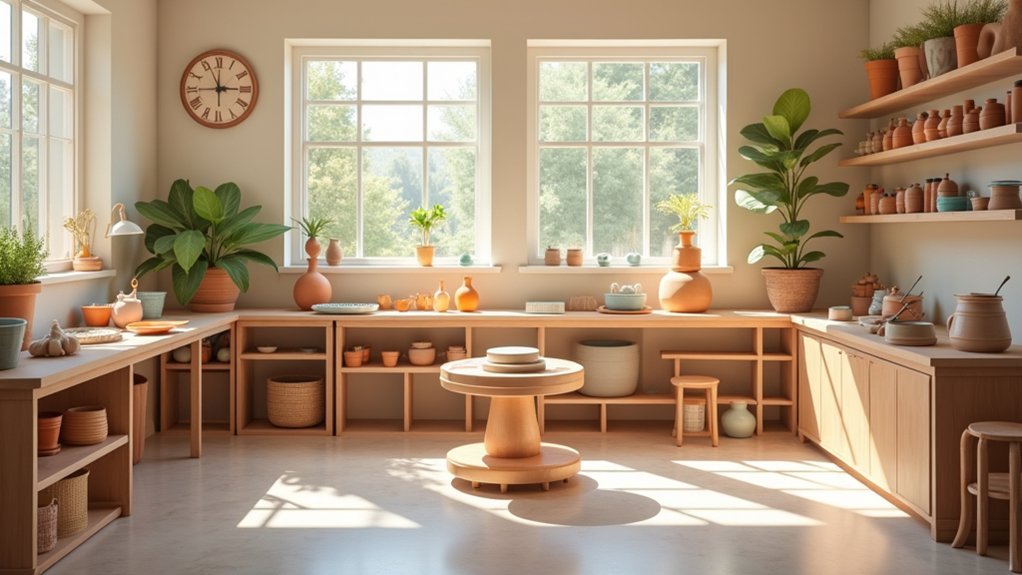
Five key elements transform a standard pottery studio into an accessible haven for wheelchair users.
Begin by positioning your main work area centrally, ensuring ample turning radius around your pottery wheel and workbench. Clear pathways with non-slip flooring are essential for safe navigation.
Install adjustable-height tables with rounded edges and sufficient leg clearance underneath.
Remember to position tools within easy arm’s reach and organize them intuitively to minimize excessive movement.
Lighting makes a significant difference—invest in bright, even illumination that eliminates shadows and highlights your wheel area.
Proper lighting transforms accessibility into artistry—illuminate your wheel to reveal every curve and contour of your creation.
Consider hand-controlled pottery wheels instead of traditional foot pedals. Incorporating aesthetic appeal in adaptive tools helps enhance the overall pottery-making experience.
Finally, don’t overlook communication needs.
Arrange your space to maximize visibility between you and your instructor, incorporating visual aids and written instructions to support your creative journey.
Choosing the Right Wheelchair-Friendly Pottery Wheel
With your accessible workspace established, selecting the right pottery wheel becomes your next priority.
Look for wheels with adjustable heights (21″-35″) that accommodate your wheelchair positioning. The best options feature sturdy steel frames with both casters for mobility and rubber feet for stability when working.
Consider wheels with variable speeds (0-240 rpm) and robust 1/2 HP motors that maintain consistent performance even when centering large clay amounts. The Brent pottery wheel delivers exceptional capability handling up to 150 pounds of clay continuously, perfect for extended creative sessions.
For ideal control, choose models offering both hand lever and foot pedal options that can be positioned according to your mobility needs.
Adjustable armrests provide essential support during throwing sessions, while EZ-Feel toggle switches and protruding indicator lights guarantee you can operate the wheel comfortably from your seated position.
These adaptable features transform pottery from challenging to fully accessible.
Essential Adaptive Tools for Clay Artists

Successful pottery creation for wheelchair users depends greatly on having the right adaptive tools at your disposal. Look for ergonomic tools with thicker, cushioned grips that reduce strain and fatigue during extended pottery sessions. Specialized tools can significantly assist potters with disabilities, enabling them to express their creativity without limitations.
| Tool Type | Adaptive Features |
|---|---|
| Handles | Thicker, cushioned grips with angled/offset designs |
| Stabilizers | Adjustable armrests and wheel-mounted tool rests |
| Grip Aids | Silicone finger supports and adaptive gloves |
| Workstations | Height-adjustable tables with clear pathways |
| Cutting Tools | Lever-operated mechanisms with enlarged finger loops |
Consider multipurpose tools that reduce the need for frequent switching, and don’t overlook stabilizing accessories like non-slip surfaces and portable clamps. You’ll work more efficiently with wheelchair-compatible supports that keep tools within easy reach, minimizing repetitive movements and conserving energy.
Ergonomic Throwing Techniques From a Seated Position
Centering clay from a seated position requires confidence and deliberate movement rather than raw strength.
You’ll find more success by positioning your wheel at the ideal height where your arms can maintain a comfortable, supported angle while working. Consider using specialized equipment like the Brent wheelchair accessible model, which features adjustable side arms and wheels designed specifically for wheelchair users.
Center Clay Confidently
Three essential elements transform clay centering from a challenging obstacle into a smooth, satisfying process for wheelchair users.
First, position your wheel at waist height or slightly above to maintain proper sightlines and reduce back strain. You’ll need a stable, adjustable wheel that won’t shift during centering. The new power wheel’s ability to raise and lower makes it ideal for finding your perfect working height.
Second, optimize your seating with a well-cushioned surface and position yourself centrally to the wheel. Angle your wheelchair slightly forward to improve reach while keeping feet on footrests for stability and leverage.
Finally, maintain proper arm positioning with elbows close to your body and wrists straight. Use your dominant hand on top while the other supports the sides. Keep both hands in continuous contact with the clay to sense its movement and make subtle adjustments as you center.
Leverage Body Mechanics
Mastering body mechanics is the foundation of comfortable, effective pottery work from a wheelchair. Position your wheel at belly button height to prevent back strain and guarantee you can see your work without craning your neck.
Anchor your forearms against your body or thighs for stability while throwing. This creates a natural fulcrum that enhances control and reduces fatigue. Engage your core muscles to maintain proper posture and generate power without straining your upper body. Consider using slanted wood pieces for proper foot positioning if you have partial lower body mobility.
Use specialized tools that extend your reach and leverage when necessary. Remember that efficient throwing isn’t about strength—it’s about positioning. Let your body weight work with gravity rather than against it.
Breathe naturally throughout the process. Tension-free breathing promotes better circulation and helps you maintain focus during extended throwing sessions.
Hand-Building Methods for Limited Mobility
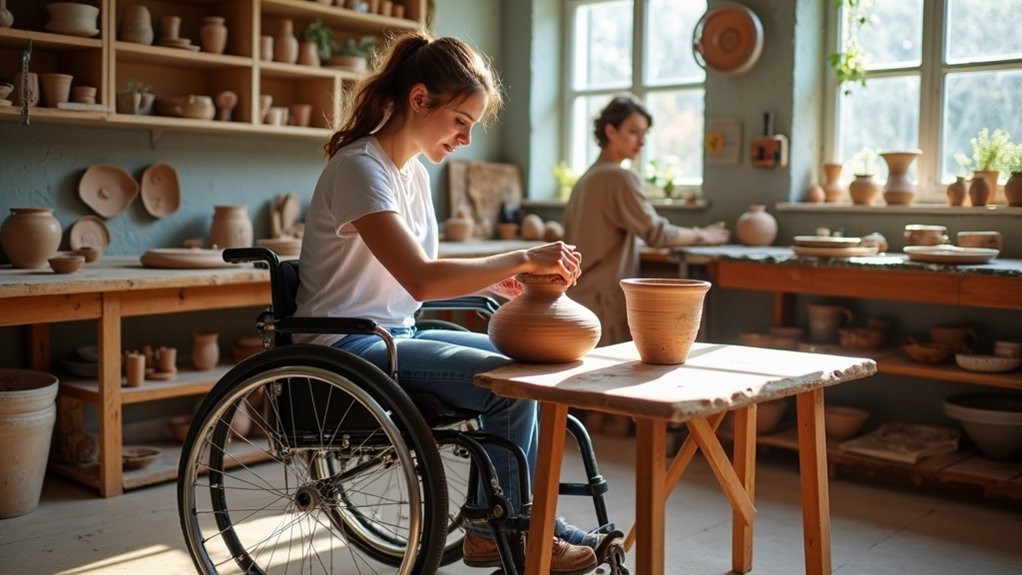
Exploring hand-building techniques offers wheelchair users multiple pathways to pottery creation without requiring wheel access. The pinch pot method is particularly accessible, requiring minimal equipment while providing maximum creative freedom. You’ll find that properly wedged clay (removing air pockets first) makes handling considerably easier. Many potters with physical limitations have found that coiling and slab-building serve as excellent alternatives to throwing when joint pain makes traditional methods challenging.
| Technique | Accessibility | Benefits |
|---|---|---|
| Pinch Pot | High | Requires minimal strength, great for beginners |
| Coil Building | Medium | Can be done in stages, less fatigue |
| Slab Work | Medium-High | Utilizes adaptive tools, creates flat surfaces |
Consider using ergonomic seating during sessions and setting up an adjustable-height workstation. Grip-enhanced tools can dramatically improve your handling capabilities, while extruders help create handles without strain. Remember that hand-building offers tremendous flexibility—you can adapt techniques to match your specific mobility needs.
Glazing Strategies for Wheelchair Users
While creating pottery brings joy to many artists, the glazing process presents unique challenges for wheelchair users that require thoughtful adaptations.
The art of pottery offers fulfillment, yet requires innovative solutions to make glazing accessible for artists who use wheelchairs.
You’ll find several techniques particularly accessible from a seated position, with the right setup and tools.
Consider these accessible glazing approaches:
- Use dipping stations with tanks positioned at appropriate heights, allowing you to submerge pieces without straining.
- Set up pouring stations with lightweight containers and turntables at wheelchair height for controlled application.
- Employ extended-handle brushes with ergonomic grips to reach all surfaces without uncomfortable stretching.
- Install spray booths with adjustable-height platforms and easy-trigger spray guns for effortless coverage.
Keep your workspace clutter-free with tools organized within reach, and utilize non-slip mats to stabilize pieces during the glazing process. Attending inclusive art classes like those led by Nick Kraft can provide valuable insights on adaptive pottery techniques specific to your needs.
Studio Navigation and Safety Considerations
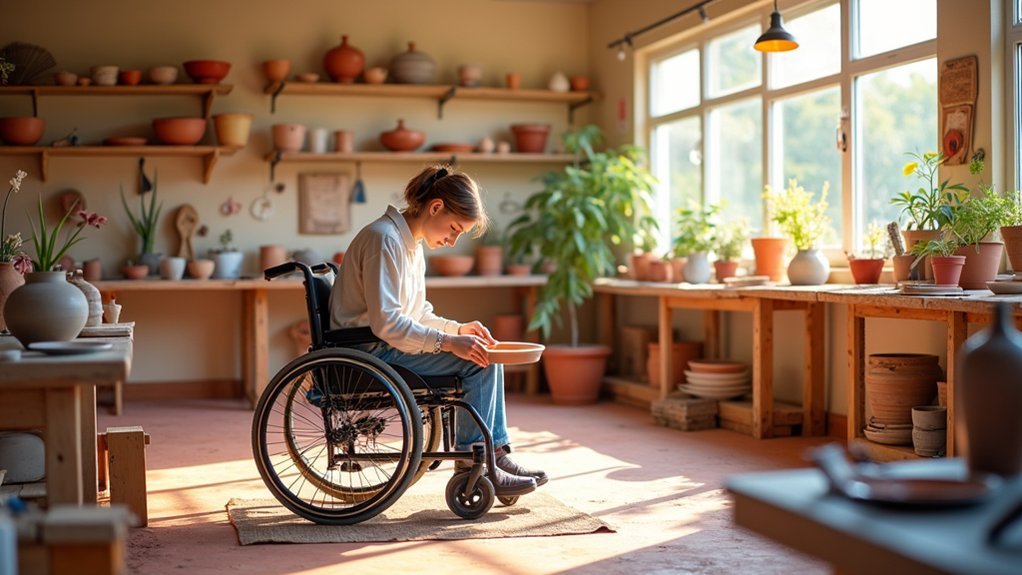
Beyond the glazing techniques themselves, your ability to navigate the pottery studio comfortably and safely directly impacts your creative experience as a wheelchair user.
Wide, obstruction-free pathways allow you to move independently throughout the space, enhancing your artistic flow.
Look for studios with wheelchair-friendly workstations and height-adjustable surfaces that accommodate seated throwing techniques.
Non-slip mats around your wheel provide essential stability, while secure equipment fastening prevents accidents.
You’ll benefit from accessible tool storage within easy reach.
When evaluating a studio, check for clear navigation paths and ample floor space around pottery wheels.
Don’t hesitate to suggest layout improvements – regular assessment guarantees the environment remains accessible.
The most supportive studios welcome your feedback and continuously adapt their spaces to better serve your creative journey.
Community Resources for Adaptive Pottery Classes
Finding accessible pottery instruction shouldn’t be a barrier to your creative expression as a wheelchair user. Many community studios now offer specialized programs with redesigned workspaces featuring open floor plans and modified equipment.
Look for these resources in your area:
- Local council-supported pottery programs that collaborate with disability advocates to create inclusive class environments.
- Studios offering specialized wheels like the Brent Model 16 with adjustable heights and armrests.
- Community classes with adaptive tools featuring ergonomic handles for those with limited grip strength.
- Regional exhibitions connected to adaptive pottery programs that showcase work from artists with disabilities.
Many studios provide individualized instruction focusing on your strengths, using multimodal teaching methods to guarantee you can fully participate in the creative process. The best options include facilities with fully accessible wheels that feature variable speed control to accommodate different skill levels and physical abilities.
Showcasing Work: Exhibition Tips for Artists With Disabilities
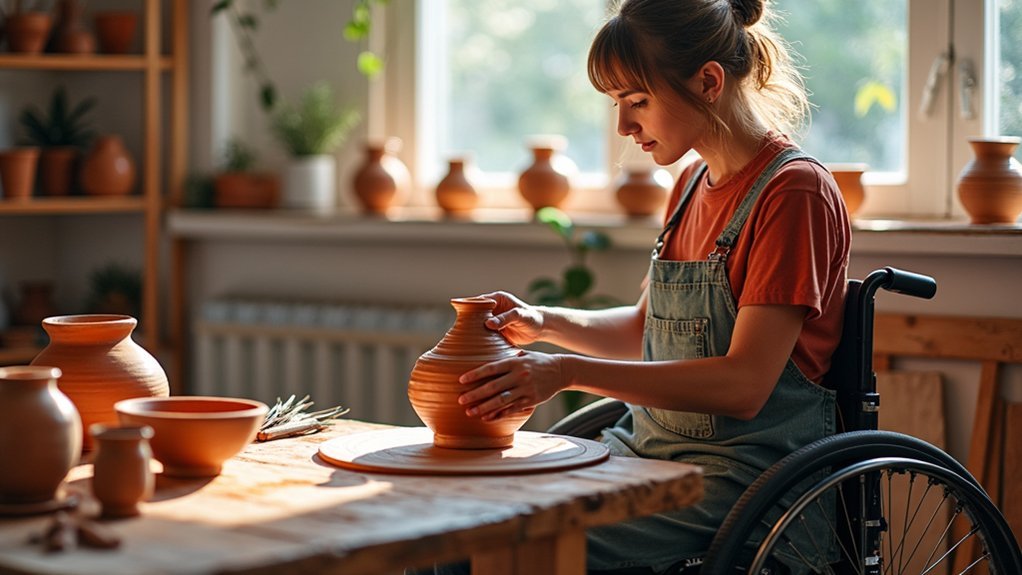
The spotlight of exhibition demands thoughtful planning for wheelchair artists to truly shine.
When displaying your work, make sure pieces are mounted at 135 cm center height for ideal viewing from seated positions. Request display podiums at accessible heights (around 80 cm) to showcase three-dimensional pieces effectively.
Work with curators to maintain 1.3 m clearance between displays for easy navigation in your wheelchair. Consider using tactile elements in your exhibition to engage visitors with various sensory needs. Your artist statement and work labels should be available in multiple formats—consider large print, audio descriptions, and Braille options.
If your work includes interactive or audiovisual elements, provide clear captions and adjustable volume controls.
Don’t hesitate to request seating areas throughout the exhibition space—this benefits you during opening events and guarantees all visitors can comfortably experience your artistic vision.
Therapeutic Benefits of Clay Work for Wheelchair Users
Working with clay offers you a powerful mind-body stress release through its tactile nature and mindful process.
You’ll discover opportunities to build community connections as you share experiences in pottery workshops designed for wheelchair users.
Regular clay work can strengthen your fine motor skills while providing a creative outlet that boosts confidence and emotional well-being. Clay therapy provides a safe environment for processing emotions and can help with past trauma through non-verbal expression.
Mind-Body Stress Release
Everyone searches for ways to relieve stress, but wheelchair users often face unique challenges in finding accessible activities that provide both physical and emotional release.
Clay work offers a powerful solution through its unique tactile properties that engage both mind and body simultaneously.
When you work with clay, you’ll experience:
- The calming sensation of kneading and molding that releases physical tension while reducing anxiety
- A natural pathway to mindfulness as your focus shifts entirely to the clay’s texture and form in your hands
- The satisfaction of channeling emotions non-verbally through the clay’s transformation
- A meditative state that lowers stress markers while providing gentle upper body movement
This sensory engagement creates a therapeutic experience that supports emotional regulation without requiring verbal expression. Research shows that regular clay therapy sessions can significantly increase happiness scores while simultaneously decreasing depression and anxiety levels in individuals with physical disabilities.
Community Building Opportunities
Why does clay work foster such powerful connections among participants? The tactile nature of clay naturally brings people together in shared creative spaces, breaking down social barriers that wheelchair users often encounter.
You’ll find yourself naturally engaging in both verbal and non-verbal communication as you work alongside others at the pottery wheel. Clay therapy provides a powerful avenue for expression, especially serving as a non-verbal outlet for emotions when speech is difficult.
Clay workshops provide safe environments for expressing emotions that might otherwise remain bottled up. When you participate in group projects, you’ll develop teamwork skills while building meaningful relationships with fellow artists.
These connections often extend beyond the studio, creating support networks that enrich your life in unexpected ways. The collaborative atmosphere of pottery classes helps combat isolation, replacing it with a sense of belonging and community purpose that’s difficult to find elsewhere.
Improved Fine Motor Skills
Beyond the social benefits of pottery, the physical advantages offer equally meaningful rewards for wheelchair users. Your hands become stronger and more capable through regular clay work, enhancing your ability to manage daily tasks independently.
Working with clay delivers targeted exercise for your fine motor skills through:
- Gentle resistance that builds hand strength without strain
- Precision movements that improve coordination between fingers and eyes
- Repetitive techniques that enhance dexterity over time
- Tactile feedback that stimulates neurological connections
As you shape and mold clay, you’re simultaneously developing the skills needed for buttoning clothes, opening doors, and handling small objects.
This therapeutic practice offers both creative fulfillment and practical improvement in hand function, making pottery a uniquely valuable activity for wheelchair users. Many practitioners find pottery provides a similar therapeutic outlet to massage, alleviating frustration while promoting overall well-being.
Frequently Asked Questions
How Do I Manage Wet Clay Storage From a Wheelchair?
You’ll manage wet clay storage by using sealed plastic bags, placing them in lightweight containers at accessible heights. Store smaller portions, use rolling carts, and maintain airtight seals to keep your clay moist and easily reachable.
Can Service Animals Safely Accompany Users in Pottery Studios?
Yes, service animals can safely accompany you in pottery studios, but you’ll need to guarantee they’re leashed, controlled, and kept away from hazardous materials, kilns, and dust. Studios must legally permit their presence.
What’s the Best Clothing to Prevent Clay Damage to Wheelchairs?
To prevent clay damage to your wheelchair, wear a denim or canvas split-leg apron without pockets, with secure fastenings. You’ll also benefit from specialty covers for wheelchair components and abrasion-resistant gloves.
How Do Temperature and Humidity Affect Wheelchair Users Differently?
You’ll experience temperature and humidity differently as a wheelchair user due to altered thermoregulation, reduced sweating areas, and limited mobility to seek comfort. You’re more vulnerable to both heat stress and cold exposure.
Are There Insurance Considerations Specific to Adaptive Pottery Studios?
Your adaptive pottery studio needs specialized insurance coverage for adaptive equipment, ADA compliance, liability for mobility aids, and business interruption that accounts for equipment repair delays. You’ll also need workers’ comp for disabled employees.
In Summary
Your pottery journey doesn’t end with your wheelchair. With the right setup, adaptive tools, and techniques, you’ll create remarkable clay pieces while protecting your body. Don’t hesitate to connect with adaptive pottery communities—they’re invaluable resources for continued growth. Remember, clay work isn’t just about creating art; it’s therapeutic, empowering, and a powerful form of self-expression that’s rightfully yours to explore.

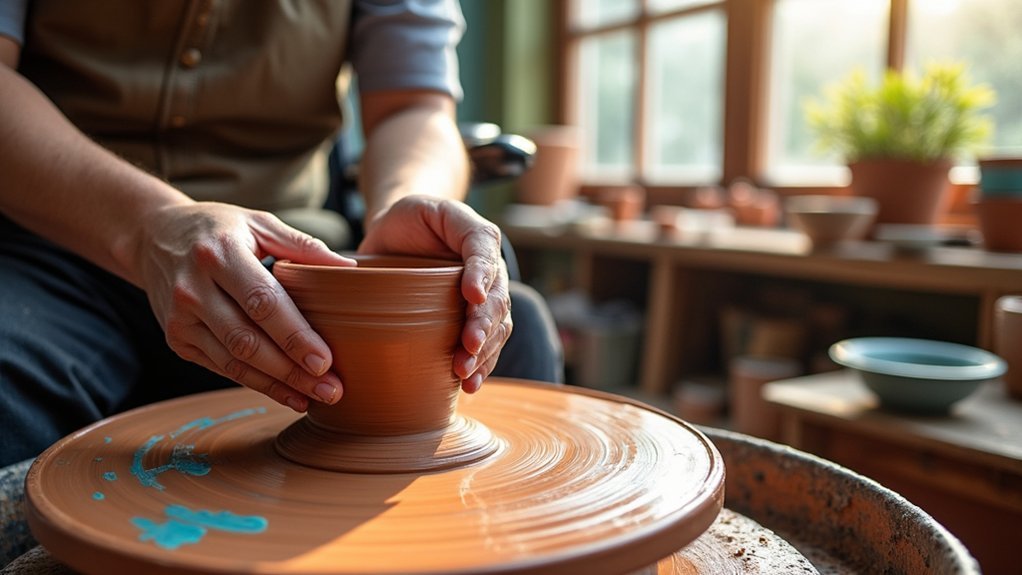



Leave a Reply